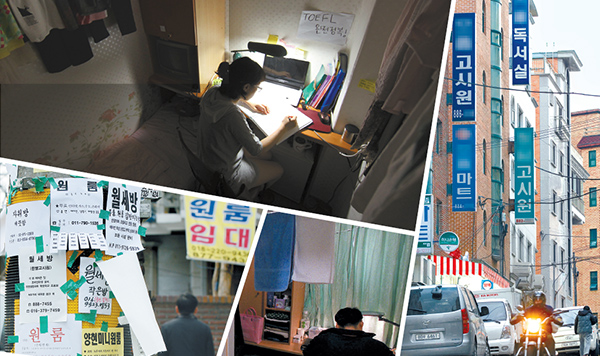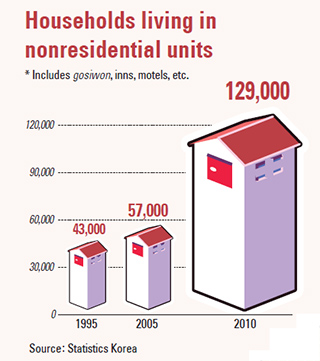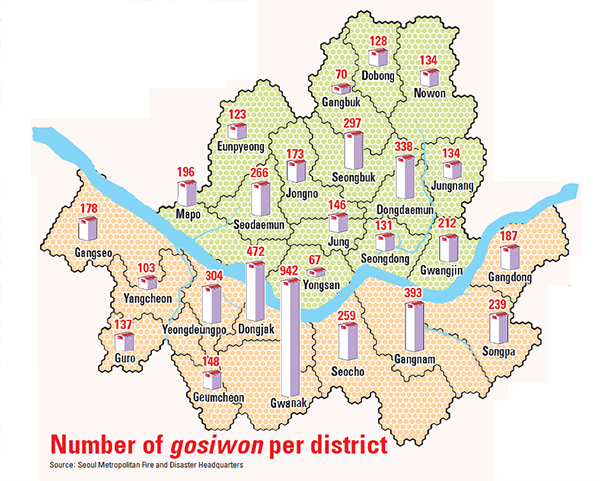Students aren’t the only ones cramming in gosiwon

Gosiwon, or facilities packed with tiny one-room accommodations, used to cater to students who confined themselves to avoid distractions while studying for national exams. But it now functions as a home for recent college graduates who can’t afford to rent a house and even the homeless who scrap together enough money to pay a month’s rent. [JoongAng Photo]
The four-story crumbling building down an alley of central Seoul is way too rundown for someone to live in permanently. A shoddy sashimi restaurant on the first and second floors manages to attract boisterous drunk diners until the early morning, and a sketchy hof, or Korean-style pub, with flickering neon signs doesn’t attract a better crowd one floor up.
Inside, it’s dim in the broad daylight and the stairs are covered in dirt. Four floors up is the Hanseong Oneroomtel Gosiwon, where people have lived temporarily for decades in Seosomun, a business district in the heart of the capital.
The owner of the gosiwon, a facility packed with tiny one-room accommodations, tried to make the name sound fancy by adding a sign that reads “Oneroomtel,” a Konglish term that avoids the negative associations that often come with gosiwon. But don’t be fooled. Oneroomtels, gositel and livingtels are all the same thing.
The size of the rooms are generally no bigger than two meters (6.6 feet) long and one meter wide. Many find they can flush the toilet while lying in bed. While some may find that convenient, more say it’s so small they can hardly move around or find space for clothes.
And then there are the neighbors. Every cough, sneeze and burp is likely to be heard through the thin walls. There’s no noise from the street to drown out the sobbing man next door because if there’s a window, it’s a tiny slot that looks out into the hallway, mostly for ventilation purposes.
The confined and densely populated spaces seem as though they wouldn’t pass a fire safety inspection, but the owner proudly points to the fire escape map in every room. She also guarantees resident safety because she sleeps in the gosiwon herself and “stays all day long.”
One night would be plenty, but the owner says she has recently seen more and more people ask for long-term accommodations in her oneroomtel.
“We have 30 rooms and some tenants have been living here as long as five years,” she said.
A sign posted in the hallway that reads “No showers allowed during the morning rush hour” is a tell-tale sign that gosiwon today don’t accommodate the kind of people they used to.
The term gosiwon can be broken down into two words - gosi, which refers to national examinations, and won, which can mean center. The exams are notoriously difficult and can take years to pass. Gosiwons offered test takers a place to isolate themselves and focus on nothing other than studying for the test.
They generally cost 300,000 won ($260) to rent per month and come with a shared kitchen with complimentary rice and kimchi, although the food is often of low quality. Residents are also free from utility bills and the lump sum jeonse deposit that can cost millions of won.
The number of gosiwon has been sharply increasing - but that doesn’t mean more people are studying for the national examinations.
According to the Seoul Metropolitan Fire and Disaster Headquarters, 57.3 percent of gosiwon dwellers are not studying for the exams as of 2008. The number of gosiwon in Seoul, however, went up to 5,777 as of July this year from 2,814 in 2005. And nearly 60 percent of nationwide gosiwon are located in Seoul alone.
In a telling market shift, gosiwon have emerged as the primary option for the urban poor. More specifically, gosiwon have become homes for many affected by the economic recession, unstable job market and soaring housing prices.
Statistics Korea says 43,000 households used to live in nonresidential facilities including gosiwon, inns and motels in 1995, but the number shot up to 129,000 in 2010.
Park Su-hyeon, a lawmaker of the Democratic United Party, says the gosiwon trend is a sign of government failure.
“An increasing number of people are living in nonresidential facilities. It is an obvious sign that the housing policies of the government are failing.”
Whatever the cause, it’s clear there has been a dramatic shift in both the demand and supply sides of the gosiwon market.
“Gosiwon have sprung up in the last few years and competition is getting fiercer than ever before,” says an official at the Central Association of Korean Gosiwon. “That’s why they have started to offer rice, kimchi and even instant noodles for free to attract more tenants.”

Gosiwon first appeared back in the 1980s and ’90s around areas like Noryangjin in central Seoul where there are many private institutes, targeting students preparing for state examinations. But they soon became common places for day laborers and the unemployed to stay after the 1997 Asian financial crisis.
Novelist Park Min-kyu described the scene in a short story published in 2004 called “Gapeul Gosiwon Stay.”
“It was closer to a coffin than a room,” he wrote. “There were still a number of people who studied for state exams in 1991, but gosiwon also started to greet laborers and people who worked in the red-light districts.”
College graduates who just landed jobs in Seoul are also regulars at gosiwon.
Kim Jin-young, a native of Busan, is one resident of a gosiwon. She’s been living in the small space for seven months in Jamsil, southeastern Seoul, one of the most expensive areas in the capital. But she pays 270,000 won per month and it takes just five minutes to walk to work, which helps her cut back on costs.
When asked what made her settle down in a gosiwon, which has become a frequent setting for arson attacks and murders, she said, “I wanted to live within my budget without burdening my parents.”
The jeonse system requires that tenants put down a large deposit, which varies depending on the location. Most have to put down at least 10 million won to live in a one-bedroom apartment in Seoul.
The money is returned after the lease ends, but for those with minimal savings it can be very difficult to find housing. Without help from parents, nestling down in a decent room in Seoul is not easy for graduates like Kim.
Park Ki-deok, 28, has been living in a gosiwon for six years. Park wants to move into a bigger place, so he keeps track of every won he spends. Since Park is 179 centimeters (five-foot-nine inches) tall, his feet always stick out from under the bed sheets.
“I once drew a window and attached the drawing on the wall of my gosiwon,” he said during an open forum where Seoul Metropolitan Government officials and young Seoulites gathered to discuss housing problems.
Kim Su-won, who sells The Big Issue Korea, also lives in gosiwon. By selling the London-based magazine that gives the homeless a chance to earn money, he can now support himself and pays monthly rent.
The supply
Realizing the gosiwon has become a common accommodation for many, from young employees to those scraping by, Seoul Mayor Park Won-soon promised to lower the monthly rent of gosiwon earlier this year and the Seoul Metropolitan Government also launched a task force last month.

“Gosiwon are not cheap at all,” says Kim Soo-hyun, a professor of the urban real estate graduate school of Sejong University.
Kim insists that people living in gosiwon pay 70,000 won per one square meter per month on average, but those living in Tower Palace, a residential complex in Dogok-dong, southern Seoul, often considered an icon of wealth, pay 50,000 won on average for the same space for rent. The difference is in the jeonse deposit.
“People in the low income bracket always pay more than others, not only in Korea but also in other countries,” Kim says.
“The government shouldn’t distort the market but there is a need for the authorities to come up with welfare measures for desperate people who have no choice but to resort to the gosiwon.”
Gosiwon has become home to the urban poor, but they have been largely off the government’s radar.
For example, one has to get permission from the city government when building gosiwon, but many are illegally altered afterwards to maximize profits.
Under the current law, gosiwon don’t fall under many housing regulations and it is illegal to make individual rooms equipped with cooking facilities and bathrooms. But some gosiwon owners install cooking facilities in each room.
Another issue is that many gosiwon are not safe in the case of an emergency. Starting in 2010, new gosiwon owners must install fire sprinklers, but the law does not apply to those built before 2010.
The Seoul Metropolitan Government has attempted to address these issues.
“The city will run gosiwon called Hope Gosiwon for a trial run starting March,” says Choi Seok-jin, an official at the architect planning department of the city government. By operating the city-run gosiwon, the city hopes to set standards in operating shared kitchens, toilets and other safety measures.
The city government also conducted an inspection of over 5,400 gosiwon between January and May.
“It’s hard to conduct an inspection every year, though. That’s because there are simply too many gosiwon in Seoul,” says Choi.
Since gosiwon are private properties, there is a limit to what the government can do. Experts say the government should diversify housing options beyond gosiwon.
“It’s hard to find a facility like a gosiwon in other parts of the world,” says Cho Myung-rae, a professor of urban planning at Dankook University. “That’s because housing is way too rigid here.”
By Sung So-young [so@joongang.co.kr]










with the Korea JoongAng Daily
To write comments, please log in to one of the accounts.
Standards Board Policy (0/250자)